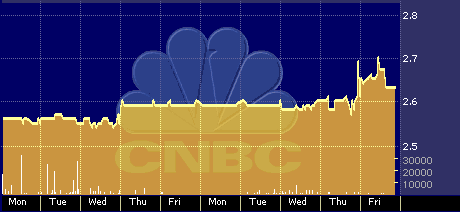
Mypoints.com Builds Loyalty and Value
Mypoints.com Builds Loyalty and Value
By Hal Plotkin
Silicon Valley Correspondent
Mypoints.com Inc. {MYPT} may have faced some bad timing with its recent IPO, but online consumer incentive company has caught analysts’ attention as a stock to watch over the next year.
The San Francisco-based company debuted on Nasdaq on August 20 at $8.00 and closed at $13.13 on its first day – a respectable showing given the current instability of the market for new Internet stocks.
However, Mypoints.com had been forced to lower its target price from between $10 and $12 a share because of weak demand, and it would have undoubtedly performed much better earlier this year, when Internet stocks saw unprecedented run ups in IPO trading.
But Mypoints.com is expected to prosper in the long run, as more online vendors seek ways to hold onto their customers.
“The really big opportunity will come in about 2001,” says Fiona Swerdlow, principal analyst at Jupiter Communications, based in New York. “That’s when more than half of all online users are expected to also be online purchasers.” Swerdlow recently authored a comprehensive report about online customer-loyalty programs.
Similar to airline frequent-flyer programs, Mypoints.com awards points to consumers for shopping at a variety of online vendors.
The points can be redeemed for everything from books and records to meals and hotel accommodations.Shoppers who register with Mypoints.com acquire points for visiting certain Web sites or reading advertisements e-mailed to them, in addition to the points they rack up whenever they actually buy something from a participating merchant.
“They are clearly the market leader in that arena,” says Phil Daniels, an Internet analyst at PC Data Online, based in Reston, Va.

MYPT stock price chart since its IPO
Mypoints.com, founded in 1997, was the 30th most-popular Web site last month, with almost 10 percent of all Internet users visiting the company’s home page at least once that month, according to PC Data Online. During that month, the company’s site generated 342 million page views, compared with 331 million in May and 270 million in April.
What’s more, Mypoints.com appears to be doing a better job than many other Web sites of holding onto its user base, a task that is proving more and more difficult as the sophistication level of the average Internet user increases.
“We’re finding that once people get comfortable with the Internet, many of them start going directly to the sites that interest them instead of going through an intermediary,” Daniels says.
Getting people to come back to their site and to repeatedly visit the sites’ of the company’s marketing partners, is central to Mypoints.com’s strategy.
“Acquiring a new customer costs an average company six times what it costs to retain an old customer,” says Chris Hansen, an analyst at Banc of America Securities in San Francisco. “Online customer-loyalty programs are going to be very important in the future,” he says. “It’s really nothing new. It’s just new to the Internet. You can already see how crucial they are for companies such as airlines and grocery stores.”
They are also crucial for many consumers, particularly well-healed consumers. Of nearly 2000 online purchasers recently surveyed by Jupiter Communications, 56 percent say they are more inclined to purchase goods from an online vendor that offers affinity points. In the higher-income bracket, defined as consumers who earn more than $75,000 a year, 64 percent are attracted by a point-rewards program.
“Loyalty programs are going to be one of the key things driving repeat business on the Internet,” Swerdlow says. “Right now, though, most e-commerce companies remain focused on acquiring new customers, not retaining them. But they’re crazy not to start thinking about this.”
The market opportunity for companies supplying loyalty programs is largely untapped, Swerdlow says. Despite the popularity of reward programs in the off-line world, about two-thirds of the 82 top e-commerce Web sites surveyed by Jupiter late last year didn’t have any kind of customer-retention program. “It hasn’t changed much since then,” she says.
Swerdlow adds that the online world will probably follow the same route the airlines took when frequent-flyer programs took off en masse in the 1980s. “First, it was just American, and then, in a very short time, all of the airlines were doing it,” she says.
Mypoints.com faces competition on a number of fronts, including from San Francisco-based Passpoints.com, which was started last year by former Netscape executive Alan Gunshor, and by the more established Netcentives Inc., also based in San Francisco, which recently secured $36 million from a group of investors that includes American Express Co. {AXP} and Citigroup Inc. {C}.
Netcentives, pioneer of the “ClickRewards” program, employs a strategy that includes negotiating exclusive deals with vendors in a variety of consumer-goods categories.
“I’m not sure how that will play out over the long run,” Swerdlow says. “Eventually they’re going to run out of categories, and then, if they keep the strategy, they’ll be left with a limited number of companies they can work with.” Netcentives also supplies private-label loyalty programs to large e-commerce Web sites.
Late last month, Netcentives filed an initial public offering registration statement with the Securities and Exchange Commission. No date has been set for the planned offering.
Unlike Netcentives, Mypoints.com offers co-branded loyalty point-reward programs to competing vendors, Swerdlow says. The company posted sales of $1.3 million in 1998 with pro forma losses of $17.7 million, which includes costs associated with the acquisition of Experian’s Web-based rewards program. Excluding those costs, Mypoints.com’s 1998 red ink totaled $8.3 million.
Nonetheless, Banc of America Securities analyst Chris Hansen says Mypoints.com has something to show for its efforts. “The value these companies build is based on the deals they make with participating merchants,” he says. “There’s no question they are building an asset that will be important. It could make them a very attractive target for acquisition by some of the traditional, more established, off-line marketing companies.”


